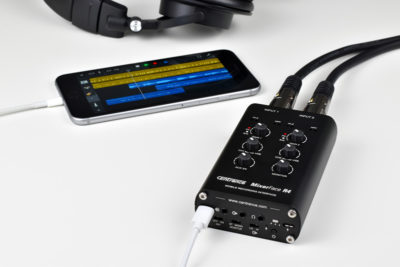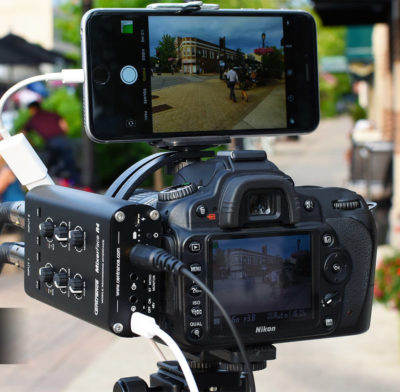New Gear Review: MixerFace R4 by CEntrance

MixerFace R4 by CEntrance is a road-ready, feature-packed, and versatile solution for your mobile recording needs.
The MixerFace R4 by CEntrance is a portable, two-channel USB audio interface intended for mobile and studio use.
Aimed at the traveling songwriter, mobile and field recordist, podcaster, or anyone else in need of an on-the-go solution for capturing quality audio content, MixerFace R4 is streamlined, compact, and road-ready.
With the increasing number of mobile recording solutions on the market, it takes creativity, innovation, and design prowess for manufacturers to deliver a product that really stands out. Today, we’ll take a close look at MixerFace R4 and see if it has what it takes.
Features
MixerFace R4 comes bearing a lithium-polymer rechargeable battery, and is compatible with iOS, Android, Windows, Mac, and Linux devices. It features two high quality mic/line/instrument preamps, stereo headphone outs for tracking and quiet listening, and stereo balanced outs to feed your external monitor system. It also has an aux out for additional analog destinations or DSLR cameras—a crucial feature for online video content creators.
The R4 resides in a sturdy aluminum case, is smaller than your average direct box, and just looks like you should take it places. Six easy-to-access knobs control the basics, while recessed micro-switches offer controls for various other settings, and there is one tiny button for power. The R4 weighs around 6 ounces (about the same as a smartphone), and captures audio at resolutions up to 192kHz/24-bit.
Each simple, yet versatile preamp has a knob for gain, and switches to set values for line/instrument and to engage a high-pass filter per channel. Each channel also comes with its own knob for zero-latency blend between the input signal and computer. There is a control to send signal from the aux input to the mix, along with a single master volume for the balanced outs and headphone jack.
Aux in, aux out, and headphone jacks are on 1/8” stereo connectors. Three switches on the front panel provide 48V phantom power, stereo or mono monitoring, and a pad for the aux out. There are two USB jacks: one for charging the internal Li-Po battery, and another that connects to a computer or phone. Three small LEDs indicate battery charge.
Another added benefit for those using MixerFace alongside video equipment is the 1/4” threaded socket on the bottom of the case, which allows the unit to be securely mounted to camera rigs and other setups. With its switches recessed and low-profile design, MixerFace looks and feels sturdy and roadworthy. It’s kind of utilitarian, it’s versatile, and it’s rechargeable. So far, so good!
In Use
Admittedly, when I first saw the recessed micro switches, I felt some doubt… but it turns out I like them. I can set up channel 1 for a ukulele and channel 2 for a vocal mic, and it stays that way without things getting nudged if I toss the unit in a bag. The settings are clearly visible from a distance with no power needed, there’s no screen, and no menus—just the basics!
CEntrance made some creative design choices in order to get the most out of each input channel. If you plug an XLR into the input combo jack, it’s mic level with 55dB of gain at your disposal. If you plug in a 1/4” TRS connector, the unit expects to see line level. With a 1/4” instrument cable and the Hi-Z switch flipped to the right, it expects a high impedance signal, such as you’d get from a guitar with magnetic pickups. The connectors on the unit are nicely situated on either end, which eliminates the “porcupine effect” of having cables coming out in every direction.
MixerFace worked as advertised when hooked up to my iPhone 6 running GarageBand. The balanced monitor output is a bit unusual being a pair of 1/8” TRS connectors configured for balanced line level, so I built a pair of 1/8” to 1/4” balanced adapters and plugged the R4 into my monitor setup. With my iPhone as a workstation monitored through my reference speakers, the sound is comparable to my full-size, trusted studio interface. I encountered a fair bit of latency while multi-tracking, but clearing the automatically-instantiated plugins in GarageBand helped a lot. Still, the R4 provides professional grade fidelity, and the ability to use my favorite microphones all over town is a huge plus. With the R4, I can have a studio pretty much anywhere.
I ran another session using the R4 as my laptop interface, which was plug-and-play like the phone (no drivers to download). I recorded vocals through a large diaphragm condenser mic, and a ukulele with a piezo pickup through the Hi-Z input to start. Bass and guitar were added later via the Hi-Z input, and everything sounded great. The preamps captured the full musical character of the voice along with the nuance of all the instruments. Monitoring through the unit was accurate and kind to my ears during long stretches of listening.
The R4 is clearly designed with battery life in mind, as it has no displays, and it uses just a few tiny LEDs, only for essential indicators. I got almost eight hours from a full charge, running the unit in different configurations, with and without phantom power. The long battery life is key for traveling, though it is not removable for fast re-ups if you were to have a spare on deck.
One unusual thing about this arrangement is that the charge and audio ports use two separate but identical USB connectors, so you’ll need both cables plugged in at once to run the unit with wired power when interfacing to computer at the same time. It should also be noted that a 2A or better power supply is preferred for charging; my 1A chargers took longer to fully charge the unit. I ran the whole enterprise smoothly from a powered USB hub that I had on hand.
Something also worth noting is that a newly released variant of the R4, the R4R, provides one-button recording to an SD card. It’s nearly identical to the R4, but with an SD card slot and a set of small transport buttons on the front of the unit. This review was conducted before the release of the R4R, but this was pretty much the only upgrade I wished for when using the R4. Wishes can come true!
To Be Critical
A small, flexible item comes with small, flexible troubles—cables! My adventures using an iPhone as a workstation were satisfying, but I had to lay it all out on a stable surface and avoid nudging the Lightning cable. And even so, I had a few connection mishaps along the way. I wouldn’t attribute this to the R4 directly, but generally to the world of small devices that plug together with adapters and cables. Also, I found that the two micro USB cables for audio and power, though outwardly similar, are not interchangeable. It turns out that some USB charging cables aren’t suitable for digital audio, so you’ll need to keep this in mind.
On another note, I wish there were one or two more segments on the level meter. It would be handy to have the meter indicate -12dB or something in that range, which is what I like to shoot for when tracking or recording live.
Summing it Up
The CEntrance MixerFace R4 is a great solution for the traveling recordist. It can be run as a stereo audio interface, or just as mic preamplifiers if needed. And while not covered in this review, the even newer R4R adds SD card recording to an already impressive package, allowing you to ditch the phone or use the SD card for simultaneous backup recording.
The R4’s high quality preamps are clean and musical, making it a great tool for songwriters, podcasters, and anyone else who needs to capture professional quality audio on-the-go. It would also be a fine interface to complement your video production setup. The R4’s wide compatibility ensures that it won’t become obsolete anytime soon, and it’s sturdy enough to tote around in a gear bag for years on end.
The $349 price tag might seem a bit steep if you’re considering just the preamps and interface, but if having a battery is key, then this is a great value as the R4 will certainly find multiple uses in and out of your studio over time. And for $100 more, you can choose the R4R with onboard recording capabilities, so there’s something for everybody at CEntrance.
Please note: When you buy products through links on this page, we may earn an affiliate commission.







